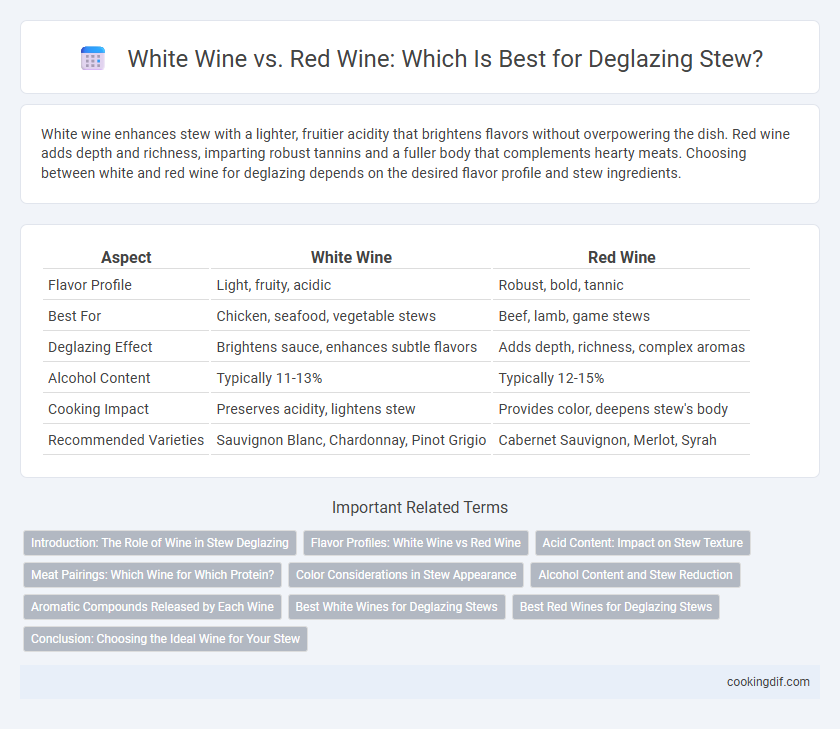White wine enhances stew with a lighter, fruitier acidity that brightens flavors without overpowering the dish. Red wine adds depth and richness, imparting robust tannins and a fuller body that complements hearty meats. Choosing between white and red wine for deglazing depends on the desired flavor profile and stew ingredients.
Table of Comparison
| Aspect | White Wine | Red Wine |
|---|---|---|
| Flavor Profile | Light, fruity, acidic | Robust, bold, tannic |
| Best For | Chicken, seafood, vegetable stews | Beef, lamb, game stews |
| Deglazing Effect | Brightens sauce, enhances subtle flavors | Adds depth, richness, complex aromas |
| Alcohol Content | Typically 11-13% | Typically 12-15% |
| Cooking Impact | Preserves acidity, lightens stew | Provides color, deepens stew's body |
| Recommended Varieties | Sauvignon Blanc, Chardonnay, Pinot Grigio | Cabernet Sauvignon, Merlot, Syrah |
Introduction: The Role of Wine in Stew Deglazing
Wine enhances stew deglazing by dissolving browned bits on the pan, intensifying flavor with acidity and complexity. White wine offers a lighter, fruitier profile that brightens the stew without overpowering delicate ingredients. Red wine contributes richer tannins and deeper color, ideal for robust stews with red meats or hearty vegetables.
Flavor Profiles: White Wine vs Red Wine
White wine imparts a bright, crisp acidity with fruity and floral notes that enhance lighter stews, especially those featuring poultry or seafood. Red wine contributes rich, deep flavors with tannins and berry undertones, complementing hearty beef or lamb stews by adding complexity and boldness. Choosing between white and red wine for deglazing stews depends on the desired flavor balance and the protein used in the recipe.
Acid Content: Impact on Stew Texture
White wine typically contains higher acidity levels than red wine, which helps break down the fibrous texture of meat in a stew, resulting in a tender and silky mouthfeel. The elevated acid content in white wine enhances collagen breakdown and prevents the stew from becoming too dense or gelatinous. Using red wine with lower acidity may impart richer flavors but can yield a thicker, less smooth stew texture.
Meat Pairings: Which Wine for Which Protein?
White wine with its crisp acidity enhances the delicate flavors of chicken and pork stews, while red wine, rich in tannins and robust flavor, pairs perfectly with beef, lamb, and game, intensifying their savory profiles during deglazing. Sauvignon Blanc and Chardonnay are ideal white wines that brighten lighter meats, whereas Cabernet Sauvignon and Merlot complement the hearty, deep flavors of red meat stews. Choosing the appropriate wine according to the protein ensures a harmonious balance that elevates the stew's complexity and richness.
Color Considerations in Stew Appearance
White wine preserves the stew's natural color, maintaining a lighter and clearer broth ideal for chicken or vegetable stews. Red wine introduces deep, rich hues, creating a darker, more robust appearance that complements beef or game stews. Choosing the wine based on color considerations enhances the visual appeal and aligns with the stew's overall presentation.
Alcohol Content and Stew Reduction
White wine typically has a lower alcohol content, around 11-13%, making it ideal for deglazing stew pans without overpowering the dish. Red wine, with alcohol content ranging from 12-15%, provides a richer, more robust flavor that intensifies during stew reduction. The choice between white or red wine affects the stew's depth of flavor and the final concentration of alcohol after simmering.
Aromatic Compounds Released by Each Wine
White wine releases higher levels of esters and terpenes during deglazing, contributing bright, fruity, and floral aromatic compounds that enhance the stew's freshness. Red wine, rich in tannins and phenolic compounds, adds deeper, earthy aromas and subtle spice notes, intensifying the stew's complexity. The choice between white and red wine for deglazing directly influences the stew's aromatic profile by altering the dominant volatile compounds released.
Best White Wines for Deglazing Stews
Dry white wines with high acidity, such as Sauvignon Blanc or Pinot Grigio, are ideal for deglazing stews because they lift the browned bits without overpowering the dish. Chardonnay, especially unoaked, offers a rich texture and subtle fruitiness that enhances the depth of flavors. Avoid sweet white wines like Riesling to maintain the savory balance crucial in stew preparation.
Best Red Wines for Deglazing Stews
Cabernet Sauvignon and Merlot are among the best red wines for deglazing stews, offering rich tannins and deep fruit flavors that enhance the savory base. Syrah and Zinfandel provide bold, spicy notes and a robust acidity that helps lift caramelized bits from the pan, intensifying the stew's complexity. Using these red wines adds a balanced depth without overpowering the natural flavors of the meat and vegetables.
Conclusion: Choosing the Ideal Wine for Your Stew
White wine brings a bright acidity that enhances lighter stews with poultry or seafood, while red wine adds rich, robust flavors perfect for beef or lamb stews. Opt for dry varieties in either color to avoid overpowering sweetness and maintain balance in your dish. Selecting the ideal wine depends on the stew's primary ingredients and desired flavor intensity to achieve the best deglazing results.
White wine vs red wine for stew deglaze Infographic

 cookingdif.com
cookingdif.com